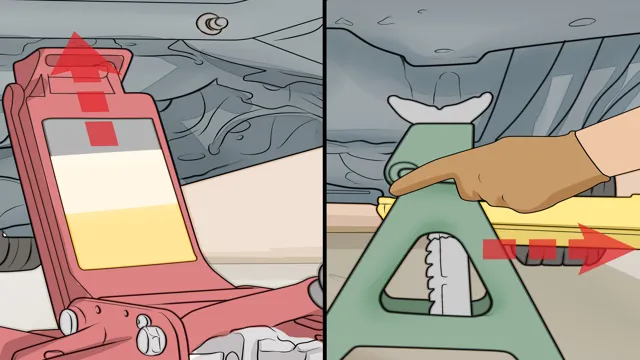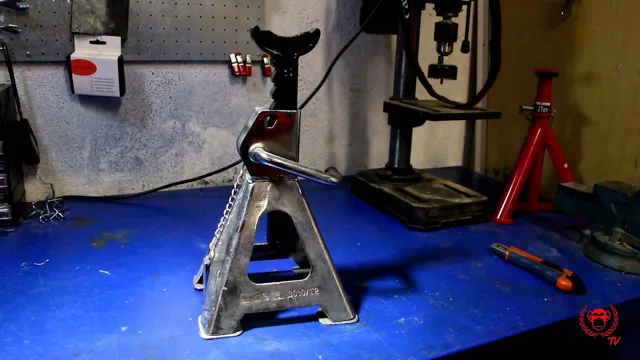How to Use Jack Stands for Oil Change: A Comprehensive Guide

When it comes to performing an oil change on your car, safety should always be your top priority. This is where jack stands come in handy. These simple but essential tools provide a secure foundation for your car, allowing you to work underneath it with confidence.
But how do you use jack stands properly and safely for an oil change? In this blog, we’ll break down the steps you need to take to ensure your car is supported correctly and that you can complete your oil change without putting yourself in danger. So grab your wrench and let’s get started!
Safety Precautions
If you’re planning on doing an oil change yourself, it’s important to ensure that you’re taking all the necessary safety precautions. One of the most important things to keep in mind is how to use jack stands for oil change. Before you begin working on your car, make sure it’s parked on a flat, level surface and that the emergency brake is engaged.
Then, using a hydraulic floor jack, carefully lift the car up and place the jack stands under the designated jack points. It’s important to make sure the jack stands are firmly in place and that the weight of the car is evenly distributed between them. Never work under a car that’s supported only by a jack – always use jack stands for added stability and safety.
Once the car is securely in place, you can begin the oil change process. With these safety precautions in mind, you can successfully and safely change your car’s oil on your own.
Block the Tires
As a responsible driver, it is crucial to take safety precautions whenever you are behind the wheel. One excellent safety measure that you can take is blocking the tires. This straightforward step can prevent your car from rolling away, causing accidents or damaging property.
To block the tires, you need to make use of tire chocks or wedges, which can keep the wheels in place and prevent them from moving. By placing the chocks at the front and back of the tires, you can add an extra layer of safety and peace of mind. Always ensure that the chocks are flush with the tires and the ground, as any gaps could render them ineffective.
Whether you are parked on a slope or a level surface, blocking the tires is an essential precautionary measure that you should never overlook. Remember, it only takes a few seconds to block the tires, but it could save you from potential harm and expenses in the long run. Stay safe on the road by blocking your car’s tires.

Place the Jack Stands
When it comes to working on your vehicle, one of the most important steps is making sure your car is properly secured with jack stands. But before you place the stands, it’s crucial to take some safety precautions. First, park your car on a flat surface, engage the parking brake and put the car in first gear (or park if you have an automatic).
Then, locate the stand points in your car’s owner’s manual and mark them off with chalk or tape. This will ensure that you know exactly where to position the jack stands so they won’t slip off. And finally, make sure that you place the jack stands on a solid and level surface that can handle the weight of your car.
By taking these safety measures, you’ll ensure that your vehicle is safely secured and prevent any accidents from happening. Keyword: Jack Stands
Lifting the Car
If you’re interested in changing the oil in your car, then it’s important to know how to use jack stands safely. Before starting work, park your car on a flat surface and turn off the engine. Locate the jack points recommended by your vehicle manufacturer, then use the jack to lift the car off the ground.
Once the jack is in position, place the jack stands on the secure area under the vehicle. Slowly lower the car onto the jack stands, ensuring they are fully locked and holding the weight of the car. With the car securely lifted, you can safely crawl underneath and change the oil.
Always follow the manufacturer’s guidelines and safety procedures to prevent any accidents. By using jack stands, you can perform maintenance on your car with peace of mind and confidence that you’re doing it safely.
Locate the Jacking Points
When it comes to lifting your car, one of the most important things to do is to locate the jacking points. These points are specifically designed to safely lift your vehicle and protect the undercarriage from damage. Your car’s owner’s manual should have detailed instructions on where to find them.
Typically, jacking points are located along the sides of the car, near the front and rear tires. It’s crucial to use the appropriate jack stand and make sure the car is stable before proceeding with any maintenance or repairs. Failing to do so could result in serious injury or damage to your vehicle.
So, take the time to locate your car’s jacking points before attempting any work underneath it. You’ll thank yourself later for doing so.
Raise the Car with the Jack
Lifting a car using a jack isn’t rocket science, but it’s still crucial to do it right to avoid any accidents. Before raising the car, it’s best to find a flat surface and engage the emergency brakes to avoid any rolling. Also, check if the jacking point is sturdy enough to support the car’s weight.
You can find the jacking points in the car manual or use the ones provided in the chassis. Once you have located the jacking point, place the jack on the right spot and begin pumping the handle gently. Keep an eye on the car’s movement as you lift it, ensuring that it’s steady and stable.
Remember that a sudden surge or a fall can cause serious injuries. That’s why it’s best to have a colleague with you that can keep an eye on the car’s motion as you lift it. Once you have lifted the car, place jack stands under the car’s safety points to prevent any accidents.
With these tips in mind, raising a car with a jack becomes a simple task that can save you money in the long run.
Lower the Car onto the Jack Stands
Lowering a car onto jack stands may seem intimidating for those who are new to DIY car maintenance. However, it is a straightforward process that requires some caution to get right. First, ensure that the car is parked on flat ground and the emergency brake is engaged.
Then, locate the jacking points under the car and use a hydraulic jack to lift the car slowly and smoothly. Position the jack stands securely under the recommended points and gently lower the car onto them. Remember to double-check that the car is stable before you start working.
Safety is the key, so take your time and avoid rushing the process. With these steps, you can safely lift and lower your car without any trouble.
Performing the Oil Change
Performing an oil change on your vehicle is a crucial maintenance task that every car owner should know and be able to do. To start, make sure you have all the necessary tools and materials handy, such as a wrench, oil filter, oil pan, funnel, and new oil. Once you have everything, park your car on a level surface and engage the emergency brake.
Next, lift your car using jack stands or a hydraulic jack, as it’s essential to have proper support to ensure safety. When using jack stands for an oil change, place them under the vehicle’s frame, not the axle or suspension. The stands should also be placed on level ground, and each should support the weight of your car.
Once your vehicle is firmly supported, locate the oil filter and drain plug and remove them carefully. While it’s draining, take the opportunity to inspect the filter for any damage or wear. After the old oil has finished draining, replace the oil pan plug and filter and fill your engine with fresh oil, according to your car’s recommended quantities.
Finally, remove the jack stands and slowly lower your vehicle to the ground. Congratulations, you have now completed an oil change using jack stands correctly!
Remove the Drain Plug
When it’s time for an oil change, the first step is to remove the drain plug. This is usually located on the bottom of the oil pan and requires a wrench to loosen. Be sure to have a catch pan underneath to catch the old oil as it flows out.
Once the drain plug is removed, give it a quick inspection to ensure it’s not damaged. If it looks worn or stripped, replace it with a new one. When all the oil has drained out, put the drain plug back in and tighten it with the wrench.
It’s important not to over-tighten, as this can cause damage to the oil pan. With the drain plug back in place, you’re ready to move on to the next step in the oil change process. By doing this simple task, you’ll be helping to prolong the life of your vehicle’s engine and ensuring smooth operation.
Replace the Filter
Replacing the filter is an important part of performing an oil change on your vehicle. The filter is responsible for removing contaminants from the oil to prevent excessive engine wear and damage. Without a clean filter, the oil in your engine can become dirty and ineffective, leading to poor performance and decreased fuel efficiency.
When changing the oil, it’s crucial to also replace the filter to ensure that your engine stays protected and runs smoothly. Think of the filter as the air purifier in your home – it removes the harmful particles and toxins from the air, making it safe and clean to breathe. Similarly, the oil filter works to remove the impurities from the oil, ensuring that your engine receives clean lubrication.
So when it’s time for an oil change, don’t forget to also replace the filter to keep your car running at its best. Plus, a new filter is a relatively inexpensive investment compared to the cost of costly engine repairs!
Lowering the Car and Removing Jack Stands
Now that the oil change is complete, it’s time to lower the car and remove the jack stands. You’ll want to start by removing any wheel chocks or blocks that you may have used to secure the car. Then, using your jack, carefully lower each wheel until they are touching the ground.
Once all four wheels are on the ground, it’s time to remove the jack stands. Start with the rear stands first, carefully lifting them out from under the car. Then, move to the front stands and repeat the process.
Now that the car is safely lowered to the ground, double check that all bolts and screws are properly tightened before taking your car for a test drive. Remember, safety should always be the number one priority when using jack stands for an oil change.
Conclusion
In conclusion, using jack stands for an oil change is like taking a break from a marathon. Just as you need a moment to catch your breath, your vehicle needs a break from the continuous wear and tear of the road. By safely elevating your car on jack stands, you give it the chance to relax and rejuvenate while you undertake routine maintenance.
So the next time you’re changing your oil, don’t forget to jack it up and give your vehicle the much-needed TLC it deserves!”
FAQs
What are jack stands?
Jack stands are a type of tool used to support a vehicle while it is being worked on, such as during an oil change.
How many jack stands do I need for an oil change?
You will typically need two jack stands for an oil change, as this allows you to lift one side of the vehicle at a time.
Where should I place the jack stands for an oil change?
Jack stands should be placed on a sturdy and level surface under the vehicle’s recommended lift points, which are often indicated in the owner’s manual.
How do I properly lift the vehicle with a jack before placing the jack stands?
Use a hydraulic floor jack to lift the vehicle at the recommended lift points and then gradually lower the vehicle onto the jack stands one at a time.
Are there any safety tips I should follow when using jack stands for an oil change?
Yes, some important safety tips include ensuring the jack stands are rated to support the weight of your vehicle, testing the stability of the stands before working under the vehicle, and never using makeshift platforms or bricks as substitute for jack stands.
Can I use jack stands for other types of repairs or maintenance?
Yes, jack stands are a versatile tool that can be used for a variety of repairs and maintenance tasks, such as changing brakes, replacing tires, or inspecting the underside of the vehicle.
How do I store jack stands properly when not in use?
To keep your jack stands in good condition and prevent rust or wear, store them in a dry, cool place and inspect them regularly for any signs of damage or wear.



